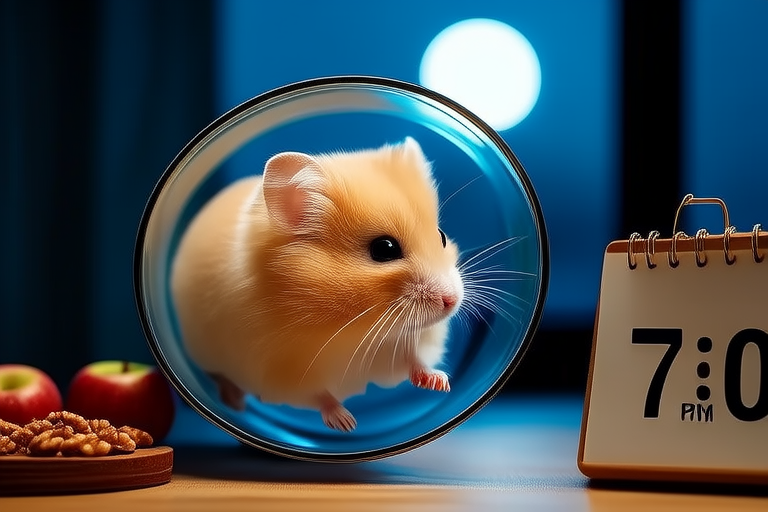
From Nighttime to Daytime: Tips for Adjusting Your Hamster’s Sleep Schedule
Hamsters are fascinating creatures with unique sleep patterns that differ significantly from humans. Understanding these patterns is crucial for ensuring your pet’s well-being and happiness. This article provides a comprehensive guide on adjusting your hamster’s sleep schedule from nighttime to daytime, covering everything from understanding natural sleep patterns to creating a conducive environment.
Understanding Hamsters’ Natural Sleep Patterns
Hamsters are nocturnal animals, meaning they are most active during the night and sleep during the day. In the wild, this behavior helps them avoid predators while foraging for food. Domesticated hamsters, however, can adapt to some extent, especially if their environment is carefully managed.
On average, hamsters sleep for about 10 hours a day, interspersed with short periods of activity. They tend to have multiple naps throughout the day, which can make it challenging to predict when they will be awake or asleep. However, understanding these patterns can help you anticipate their behavior and adjust their sleep schedule accordingly.
Signs of an Improperly Adjusted Sleep Schedule
If your hamster’s sleep schedule is not properly adjusted, you may notice several signs. These include excessive sleepiness during the day, difficulty waking up at night, and reduced activity levels. Additionally, your hamster may become irritable or stressed, leading to behavioral changes such as biting or hiding more frequently.
It is important to address any issues promptly to prevent long-term health problems. If you suspect that your hamster’s sleep schedule is off, consult with a veterinarian for professional advice.
Step-by-Step Methods to Gradually Change Their Sleep Schedule
Adjusting your hamster’s sleep schedule requires patience and consistency. Here are some steps to help you transition your pet from a nighttime to a daytime schedule:
- Identify the Current Schedule: Observe your hamster’s current sleep patterns for a few days. Note when they wake up, eat, play, and go back to sleep. This will give you a baseline to work from.
- Gradual Adjustment: Start by making small changes to your hamster’s routine. For example, if your hamster currently wakes up at midnight, try moving their feeding time forward by 30 minutes each day. This gradual approach will help minimize stress and confusion for your pet.
- Increase Daytime Activity: Encourage your hamster to stay awake during the day by providing stimulating activities. Rotate toys, add tunnels, and offer new items to explore. This will help them associate daytime with fun and excitement.
- Dim the Lights at Night: Create a dark environment at night to encourage sleep. Use blackout curtains or cover the cage with a blanket to simulate nighttime conditions. Ensure that the cage is placed away from windows or other sources of light.
- Consistent Routine: Establish a consistent daily routine for feeding, playing, and cleaning the cage. This will help your hamster understand when it’s time to wake up and when it’s time to sleep.
Creating a Conducive Daytime Environment
To encourage your hamster to be more active during the day, you need to create a comfortable and stimulating environment. Here are some tips:
- Provide Plenty of Toys: Hamsters love to chew and dig. Offer a variety of toys that stimulate their natural instincts. Tunnels, wheels, and chew toys are excellent choices.
- Rotate Toys Regularly: Keep your hamster engaged by rotating their toys every few days. This will prevent boredom and keep them interested in their surroundings.
- Offer Fresh Vegetables: Introduce fresh vegetables during the day to encourage eating and social interaction. Make sure to choose safe vegetables and avoid those that could cause digestive upset.
- Create a Quiet Space: Ensure that your hamster has a quiet space where they can retreat when they need a break. A cozy hideaway or nesting box will provide comfort and security.
Maintaining Nighttime Tranquility
While you’re encouraging your hamster to be more active during the day, it’s equally important to maintain a calm and peaceful environment at night. Here are some tips:
- Use Soft Lighting: If you need to check on your hamster at night, use a soft red light instead of a bright white one. This will minimize disturbance and allow your hamster to sleep peacefully.
- Avoid Loud Noises: Keep noise levels low at night to prevent startling your hamster. This includes avoiding loud music, sudden movements, or conversations near the cage.
- Limit Handling: Avoid handling your hamster too much at night. While it’s tempting to interact with them, frequent handling can disrupt their sleep and lead to stress.
- Keep the Cage Away from Drafts: Place the cage in a location that is free from drafts and direct airflow. This will help maintain a stable temperature and prevent discomfort.
Ensuring the Process is Stress-Free for Your Hamster
Adjusting your hamster’s sleep schedule can be stressful for both you and your pet. Here are some tips to ensure the process is as stress-free as possible:
- Be Patient: Remember that changing a hamster’s sleep schedule takes time. Be patient and give your pet plenty of time to adjust. Rushing the process can lead to confusion and stress.
- Observe Your Hamster: Pay close attention to your hamster’s behavior during the adjustment period. Look for signs of stress, such as excessive grooming, hiding, or reduced appetite. If you notice any of these signs, slow down the process and give your pet more time to adjust.
- Offer Comfort: Provide extra comfort during the adjustment period. Offer additional bedding, nesting material, and toys to help your hamster feel secure and relaxed.
- Stay Consistent: Consistency is key when adjusting your hamster’s sleep schedule. Stick to the same routine every day, even if progress seems slow. Over time, your hamster will learn to expect certain activities at specific times.
Conclusion
Adjusting your hamster’s sleep schedule from nighttime to daytime requires careful planning and attention to detail. By understanding their natural sleep patterns, identifying signs of an improperly adjusted schedule, and following the step-by-step methods outlined in this article, you can successfully transition your pet to a more compatible schedule. Creating a conducive daytime environment and maintaining nighttime tranquility will further support this process. Most importantly, remember to be patient and consistent throughout the adjustment period. With time and effort, you’ll be able to enjoy quality time with your hamster during the day while ensuring their well-being and happiness.






